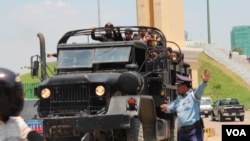Drivers on Cambodia’s chaotic streets are often quick to criticize the traffic police, who seem unable to bring things under control. However, the drivers themselves forget that poor driving and the ignoring of traffic laws lead to so many snarls.
The government has sought to break up traffic congestion through new laws, more roads, traffic lights, security cameras at major intersections and even the presence of youth volunteers on weekends. Yet drivers seem unwilling to cooperate. And while many complain that the police or government is to blame, many overlook the roles of drivers themselves.
On any day in Phnom Penh, you can see drivers who speed up when lights turn yellow, or push forward into congestion. Three-wheeled tuk-tuks take up space in the motorcycle lanes, and often side roads are used by businesses or for parking. All of this jams traffic and leads to worse congestion.
“The traffic jam issue is a challenge for all of us,” said Sum Chhum, vice president of Think Tank Cambodia, which organized a forum on Cambodia’s traffic recently. “This is not something caused by traffic police. We all have to contribute because it affects everybody, affects lives, causes damage to property and the well-being of the people, as well as social, economic and environmental well-being.”
Eang Ohni, deputy governor of Phnom Penh, said at the conference that traffic jams are the result of a lack of respect by drivers of all the measures put in place. Without cooperation from drivers, the issue can’t be resolved. Meanwhile, the number of public bus riders remains low, he said.
Kaem Leu, a social researcher, said Cambodia’s leaders much ensure they are abiding by traffic laws, to set an example. “Trying to educate people to change behaviors takes time,” he said. “Yet being a model makes it quicker.”
In nations like South Korea and Japan, there is no parking along many public roads. Drivers must park in underground lots beneath high-rise buildings and then walk to their destination. Drivers there do not drive into the opposite lane, despite traffic congestion ahead.
In Japan, almost all the people use public transport, rather than their own vehicle. This helps reduce traffic congestion.
Ear Chariya, an independent advisor on traffic safety, told VOA Khmer Monday that traffic solutions require cooperation from the government, in terms of law enforcement, and from the public in abiding by the traffic laws.
“Generally the ones who violate [the law] do not accept their faults,” he said. “When they run red lights or violate signs or drive in the opposite path once in a while, they think it is all right. Yet if everyone does the same, the problem gets bigger.”
In other countries, fines are heavier, which also helps, he said. Traffic education, which should be conducted from primary school through university, is still in a fledgling state in Cambodia, he said.
Meanwhile, development continues to spread in Phnom Penh, and with it the traffic. In Cambodia, the number of vehicles rose 13 percent between 2013 and 2014. There are 3 million vehicles on the road these days. That’s lot of potential traffic.







